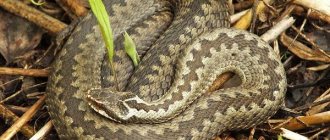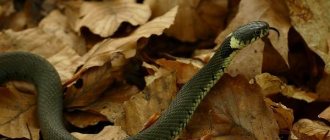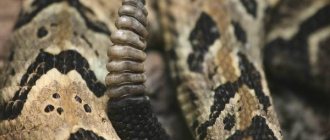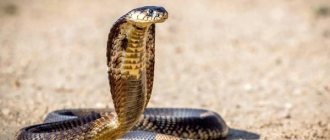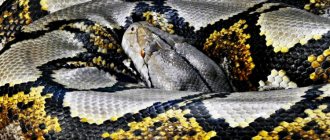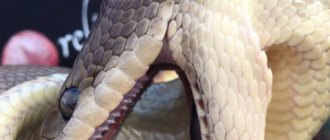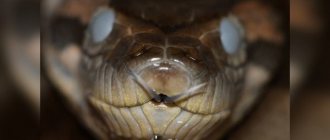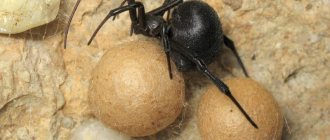What does a viper look like?
The reptile's body is emphasized by a clearly detachable head. Small scales cover the entire body. You can often find small patterns in the center of the head, which usually look like an X or V. Females most often have a brown back, while males are a grayer color. But it is possible that blue, reddish-brown, copper-red and black tints may also be present on the body of the viper. In both sexes there is often a sort of zigzag stripe running down the back, colored in dark tones. But there are individuals without any pronounced coloration.
This is how she looks in the photo.
The snake has an "eyebrow" and prominent scales above its eyes. Because of this, the expression of her muzzle takes on a stern look. A stripe is “laid” from the neck to the eyes, which only emphasizes the entire stern appearance of the reptile.
The viper reaches a length of 50 to 70 centimeters. In rare exceptional cases, specimens up to 90 centimeters in length are found. For example, the largest viper in Europe reached 87 cm in length, and the largest female in the world was discovered in central Sweden and had a body length of 104 centimeters.
Description and features
In Russia, among the variety of other species of poisonous reptiles, one most often comes across the common viper , which, due to its immunity to low temperatures, lives not only in the northern and central parts of Europe, but also on mountain plateaus, in Siberia, on the island. Sakhalin.
Many people have heard about aggressiveness and cases of attacks by reptiles, so people are interested in what a viper and whether it is easy to identify it among other harmless reptiles. The viper in the photo surprises with its variability of appearance.
More often, regardless of the background color of the body (yellow, brown, gray, brown), a dark stripe in the form of a zigzag line is clearly visible along the ridge. There are black vipers, in this case the zigzag is blurred, the tail below is yellow or orange. The weight of the snake is 100–200 g, males grow to -60–80 cm, females are heavier and 10 cm longer.
The head with a rounded muzzle is flattened, triangular, separated from the body by a cervical interception. The frontal, parietal and nasal shields are dark in color. Supraorbital scutes hang over the small brown eyes, giving the muzzle an angry expression.
The slit-like vertical pupils expand with the onset of darkness, filling the entire eye. Thanks to visual acuity, the viper does not remain hungry after a night hunt. The plump body with a short tail, tapering towards the end, is covered with scales.
Two sharp fangs grow in the upper jaw of the snake, to which ducts of glands with poison are connected. At the moment of attack, the jaws open wide, the teeth, which previously lay horizontally with the tip inward, move forward. The muscles located around the fangs contract sharply. A bite occurs with a simultaneous injection of toxins.
The internal organs of the snake are elongated and located asymmetrically one after another. The bone marrow, unlike the brain, is well developed, which determines clear coordination of the reptile’s movements and an instant reaction to changes in the situation.
Vipers, due to the specific structure of the respiratory system, where an additional tracheal lung was formed instead of the atrophied left lung, have the ability to swell when in danger and make loud hissing sounds.
Habitat of the common viper
This reptile was able to move from Asia to Europe in a few years and take root there well. This viper gained its fame due to the fact that it managed to take root north of the Arctic Circle, where no snake lives. Today it is found throughout the Alps region, the Balkans, northern Russia and eastern Asia. At the moment, the common viper is increasingly being noticed in North Korea, Mongolia and China.
In Germany, the viper especially prizes the northern German lowlands, the eastern mountain ranges and large parts of southern Germany. Especially in the Black Forest and the Swabian Alb, you can find many individuals of this species, the only venomous snake in Bavaria. Although it has been able to spread throughout Europe, its species is seriously threatened. It is for this reason that the viper has been protected for several years throughout Germany. Larger populations of the common viper can be found on Rügen and Hiddensee. This is due to the low level of human influence and the higher level of freedom for the reptile.
In Austria the situation looks a little better: a large population of common vipers lives primarily in the Mühlviertel and Waldviertel. Switzerland also has large families of these snakes, distributed throughout the Alpine region.
How does fertilization occur in a female snake?
The mating period for snakes begins after they wake up from winter sleep. At this time, they can form balls, the essence of which is that several males wriggle around the female and try to achieve reciprocity.
Only one male can fertilize a female, who, after sexual intercourse, will seal the female with a substance that is released inside his body during mating. This substance will prevent other males from fertilizing the female.
Such hissing balls can seriously frighten people nearby, especially children. And, if you have had to deal with snakes in your garden, we recommend that you purchase a snake repeller.
Lifestyle
The common viper is active mainly during the day. She loves direct sunlight. But there are also exceptions. For example, during extreme heat, its activity period shifts closer to dusk.
Mostly in the morning and afternoon, it looks for good sunbathing spots to raise its body temperature to an optimal level (snakes are cold-blooded). This averages between 30 and 33 degrees Celsius.
Shows a particularly high level of activity on humid days. The longer it rains, the more active the viper will be.
Does not tolerate wind and extreme cold. At the first signs of windy or cold weather, it hides in a warmer shelter.
In winter, it goes into hibernation, which lasts from four to seven months. This occurs in well-protected lairs, which it often shares with other vipers or, in general, with other reptiles. They generally emerge from hibernation at the end of April, beginning of May. If the cold weather drags on, the duration of sleep increases by several weeks. Males usually emerge from sleep 2 weeks earlier than females.
Wintering
Vipers leave for the winter in October. Wintering shelters, like other snakes, are voids under tree roots, under stones, rodent holes, and other underground cavities of various origins. The depth of reptiles can reach 1.5-2 meters, below the frost layer. They winter alone or in small groups. The literature describes cases when these snakes form wintering aggregations of up to 200-300 individuals.
They awaken from hibernation in April. After reaching the surface, they stay for a long time in well-warmed places, taking “sunbaths” on stumps, piles of brushwood, and stones.
Reproduction
There are only two periods of the year that the viper uses for mating. This is the period after winter fasting, and the period of mass awakening, which lasts from April to May. During the mating season, competitive fights occur between males. During the conflict, males try to defeat each other and win the affection of the female. During mating, vipers appreciate sensual foreplay, which is used to win the female. Foreplay takes a lot of time.
How do vipers give birth? In general, like many mammals. The reptile bears offspring in its body. The eggs cannot provide constant warmth, while in the womb the body temperature is maintained at a sufficient level thanks to the influx of sunlight in which the snakes bask.
Young common vipers are born most often from August to October. A newborn reptile is the size of an ordinary stationery pencil. A female can give birth to up to fifteen cubs at a time, in very rare cases up to 20 cubs.
Immediately after birth, the offspring become active and even begin hunting small lizards and frogs. The viper becomes an adult only after three to four years.
Interesting Facts
The most interesting things about vipers:
- if a newborn viper does not have time to hide in the bushes, it can serve as lunch for its parent;
- Snakes shed throughout their existence; cubs molt more often than adults due to their rapid growth;
- The Japanese, Chinese, and Koreans consider viper meat a delicacy and a remedy for healing many diseases;
- a temperature sensor on the snake's head, which helps navigate at night, can detect a difference of 0.002°C;
- reptiles are poisonous immediately after birth;
- snakes release venom when bitten in 75 out of 100 cases;
- the teeth of the African Gaboon viper grow up to 3 cm;
- Malaysians living on the island of Penang revere vipers as a sacred animal;
- steppe vipers move faster in water and in trees than on land;
- Snake aggression increases during the mating season, which occurs between March and June.
The teeth of a viper grow and change throughout its life, both as planned and when lost, this allows the snake to be always armed and ready to attack the victim.
Diet
The common viper is one of the most secretive hunters, having no specific prey preferences. Every animal found is a victim and is immediately attacked. After the attack, the reptile bites the victim and injects poison into its body. She then waits until the poison takes effect and the prey is significantly weakened before she finally dies. After this, the animal is completely absorbed by the viper.
Not only lizards, frogs and other amphibians, but also small mammals such as mice and rats are part of their diet. Also, in rare cases, the snake can eat earthworms, insects and young birds. When there is a severe shortage of food, cannibalism can flourish to a large extent.
Treatment methods after a snake bite
The effect of viper venom on the human body in most cases ends 2-4 days after the incident. But with severe intoxication, its consequences can be felt even after six months.
In the emergency department, the patient is prescribed a series of tests to assess his general condition and determine clinical and laboratory parameters. The treatment method is determined based on the results:
- general blood test;
- general urinalysis;
- measurements of fibrin degradation products;
- coagulation profile;
- levels of electrolytes, urea, creatinine.
Moderate intoxication requires an ECG, a chest x-ray and a number of additional tests. The patient is regularly monitored for 8 hours after admission. If after this no obvious symptoms of intoxication are recorded, the victim is sent home. This interval is important because the effects of the snake's venom can increase over time.
If there are severe symptoms, the patient is prescribed symptomatic therapy: sedatives for severe nervous excitement, painkillers for pain, vasopressors to eliminate shock. Treatment of a wound from a snake bite is standard, with treatment with antiseptics and regular dressing changes.
Natural enemies
Some birds of prey and mammals act as natural enemies. Larger snakes are also among the common viper's predators. Cannibalism is not unusual for snakes, given the fact that the common viper itself eats the young of other species of snakes. Here are the main predators that pose a serious threat to this species.
Predator birds:
- Buzzard.
- Black kite.
- Spotted Eagle.
- Snake eater.
- Owl.
- Gray Heron.
- White stork.
Mammals:
- Ferret.
- Ermine.
- Badger.
- Red fox.
If a reptile is attacked, it hides under stones or hides in dense vegetation. If she is cornered, she will respond with a hiss and rush at the enemy, biting him and injecting her poison (not always).
Nutrition
When obtaining food, the reptile does not catch up with the victim, but attacks from ambush. Hiding in the grass or on a tree, the snake quickly attacks unwary rodents, frogs, and lizards. The common viper eats chicks, adult passerine birds, and loves to feast on eggs.
If the hunt is unsuccessful, the reptile has to be content with insects - cicadas, grasshoppers, large beetles, butterflies. Snakes are not able to chew food, so they swallow their prey whole, creating an open angle from their jaws.
The reptile pulls its upper jaw onto the victim, holding it with its lower teeth. Then he releases his fangs and pushes the other jaw forward. With these movements, the snake pushes its prey into the throat, muscular esophagus.
Common viper venom
It is a venomous snake and creates endogenous venom that kills prey and also pre-processes it. During a dangerous situation, venom is also used for protection, but usually the snake bites its attackers without injecting venom. For example, for large opponents, such as a fox or a boar, the poison is practically harmless.
When it bites a person, you can observe similar symptoms as with a wasp bite. Swelling and redness form at the site of the bite. Then nausea and vomiting appear. This can later lead to shortness of breath, light bleeding and cramps. However, there are many cases where a person did not feel anything after being bitten.
To protect yourself, it is recommended to wear sturdy boots and long, tightly woven trousers in areas where these reptiles are likely to be present. Under no circumstances try to touch her, so as not to provoke a defensive reaction.
If she does bite, you need to remain calm. Since many snakes that do not have venom also tend to bite, identifying the snake is of utmost importance. If this fails, it is recommended to consult a doctor immediately. Under no circumstances should you resort to known home methods such as burning, sucking or picking at the bite site.
In addition, disinfection with alcohol is not recommended, because the blood is liquid and the poison spreads throughout the body in a matter of seconds. For extremely severe bites and allergic reactions, doctors will give an antidote. However, to cause serious harm to an adult, it is necessary to be bitten by an adult 7 times (equivalent to 75 mg of venom).
Siberian viper: poisonous or not?
This reptile is considered potentially dangerous to humans , since people are too large for the concentration of toxins that a snake can release. In Russia, statistics on fatal cases are not even kept, since most victims do not go to the doctor, there is no need for this.
But meanwhile, a snake bite is dangerous. Its venom is similar in composition to the venoms of other vipers; it contains proteases - enzymes that break down the peptide bond of amino acids in proteins.
However, the bite rarely leads to death , especially if the victim is an adult. Here, of course, a combination of many factors is important. For example, where the poisonous fangs stuck.
If it was the neck or face, then the likelihood of death increases greatly without timely medical assistance. But this happens extremely rarely; usually the legs are bitten.
But in any case, if you are attacked, immediately visit the nearest medical facility.
Bite
In principle, we can say that the fear of snake bites of this species is unfounded: even with minor shocks, the animals tend to retreat on their own. Care must be taken when picking mushrooms and/or berries, since at this time the person is carrying a weapon, which the snake can assess as a threat.
Snake fangs resemble injection needles known to us, which are used for medical purposes. To bite, the teeth are straightened. When she doesn't need her teeth, they disappear into the folds of the oral mucosa.
Where does it lay eggs?
At the end of July - August, females lay eggs in heaps of manure, rotten stumps, heaps of fallen leaves, that is, where, during decay, the temperature of the substrate rises and sufficient humidity is maintained. Eggs easily die from drying out. One female lays from 4 to 40 large, soft, parchment-coated eggs.
Interesting materials:
How to find out the FSS address by number? How to find out the balance on a Rocketbank card? How to find out the Batch code? How to find out if someone is online on Instagram or not? How do you know if the material is satin? How do you know when menopause is starting? How do you know when it's time to pump out the septic tank? How to find out a person's details by car number? How to find out the release date of a product by barcode? How to find out DDR3 or DDR4?
Why is the snake on the verge of extinction in Europe?
In Russia, conditions for survival are more favorable for this species. But in Europe, not everything is so smooth. In many European countries it is on the red list. In some states the viper is considered endangered, in others it is considered an endangered species.
The main reason for their disappearance is the “cutting off” of their habitat. While humans expand their scavenger environment, the corresponding habitat for snakes is constantly shrinking. Open spaces and forests are disappearing in favor of industry, roads and cities. Even in existing forested areas, reptiles' preferred breeding sites are being steadily reduced, for example through deforestation. Thus, there is a constant reduction in the habitat of vipers. For this reason, man is the main enemy of the viper.
Population and species status
The number of such reptiles is constantly declining and this is due to rapid human activity. Over the past 100 years, people have been actively engaged in draining swamps, flooding river floodplains, laying highways, developing suburban areas, etc. This leads to landscape changes and the distribution of territories into small isolated areas, which leads to a reduction in the food supply. As a result, individual populations begin to disappear either as a result of extinction or as a result of leaving their habitual places.
Despite this, the number of vipers is quite stable in regions where forest plantations are still preserved intact, although in a number of areas the common viper is listed in the Red Book. At the same time, the reptiles received the status of “vulnerable, declining species.” In the industrialized countries of Europe, the situation with vipers is generally deplorable, since their populations are declining at a tremendous rate.
Few people understand how useful the life activity of these reptiles is. For example:
- Vipers naturally influence the population of rodents, which are carriers of serious diseases.
- Thanks to a special secret, special preparations and “Anti-Viper” serums are produced in pharmacology.
Environmental organizations are interested in seeing the status of the Common Viper species change for the better.
Other extinction issues
But it is not only the destruction of the natural habitat, but also the sheer malice of man that is partly responsible for the gradual extinction of this species. Many people still believe that it is completely normal to kill both vipers and other snakes for fun.
Wild boars also often search for food under branches, where they encounter and kill snakes.
In addition, they serve larger animals such as birds of prey and mammals as a natural food source. Sometimes, even domestic cats become a real danger to snakes.
Another problem is the fragmentation of forests due to construction and highways, which surround the remaining habitats and thus provide genetic impoverishment.
How is it different from a viper? Similarities and differences between snakes.
The snake is a non-venomous snake; the viper is poisonous and deadly to humans. The similarity between a snake and a viper is obvious: both snakes can have a similar color and can be encountered by a person in a forest, meadow or near a pond. And yet, these reptiles have certain characteristics by which they can be distinguished:
- The appearance of the snake and the black viper differs, despite the same skin color. The common snake has 2 yellow or orange spots on its head, similar to miniature ears, while the viper does not have such markings.
- You should not focus solely on the color of snakes, since both snakes and vipers can be similar in color. For example, the color of a water snake can be olive, brown or black, with various spots. In addition, the black water snake does not have yellow markings on its head, making it easily confused with a pit viper. The color of the viper can also be olive, black or brown, with a variety of spots scattered throughout the body.
Water snake
- And yet, if you look closely at the spots, you can see the following difference between snakes: in snakes the spots on the body are arranged in a checkerboard pattern, many types of vipers have a zigzag stripe on the back, running along the entire body, and there are also spots on the sides of the body.
- Another difference between a snake and a viper is that the pupil of a viper is vertical, while in snakes it is round.
- The viper's mouth contains sharp teeth, which are clearly visible when the snake opens its mouth. Snakes have no teeth.
- Longer than a viper. The body length of the snake is usually 1-1.3 meters. The length of the viper usually varies between 60-75 cm, although there are individuals up to 3 meters long. In addition, vipers look much more well-fed.
- The tail of the viper is shortened and thick, while that of the snake is thinner and longer. In addition, in vipers the transition from the body to the tail is clearly defined.
- Vipers differ from snakes in the triangular shape of the skull with clearly defined brow ridges; snakes have an oval-ovoid skull.
- The anal shield of the viper is solid, while in the grass snake it consists of 2 scales.
- When meeting people, snakes try to retreat and hide; the viper will most likely show complete indifference or aggression if you step on this poisonous snake or simply brush against it.
- Snakes love damp habitats, so they can often be found near bodies of water, where they swim and catch frogs. Vipers feed mainly on mice, so they choose other habitats: forests, steppes, dense grass.
What is being done to protect them?
This species is highly protected throughout the European Union. It is forbidden to catch or kill them. Any nurseries that have snakes and offspring must prove that the offspring were bred in captivity and not taken from their natural habitat.
There are also special development measures for habitats in numerous forests that are designed specifically for this species. Sunny areas are created in the forests, which are used as a mating site and for sunbathing for reptiles, which in turn significantly increases their birth rate. However, even such serious measures are not enough to ensure the survival of the species on a permanent basis.
If you are too lazy to read, then just watch the video.
Snake lifestyle
For living and wintering, these snakes choose holes and cracks in the ground about two meters deep, where the temperature does not drop below +2 degrees. Here they wait out the cold and appear on the surface only in April.
The main food is small rodents, lizards, insects. But not only. If an animal finds a bird's nest in the grass, the chicks or eggs may be eaten.
This reptile is viviparous; the development of the egg and the birth of the young occur inside the female. Baby snakes that are born are immediately poisonous.
The main enemy in nature are hedgehogs. They are immune to poison and can kill snakes. Having found a victim in the forest, the hedgehog bites its body and quickly curls up into a ball. Then he repeats the maneuver as many times as necessary to kill her. The snake has no other enemies in the forest.
Also, in these videos, humans pose a great danger, people exterminate snakes for sale, and also destroy their natural habitats.
